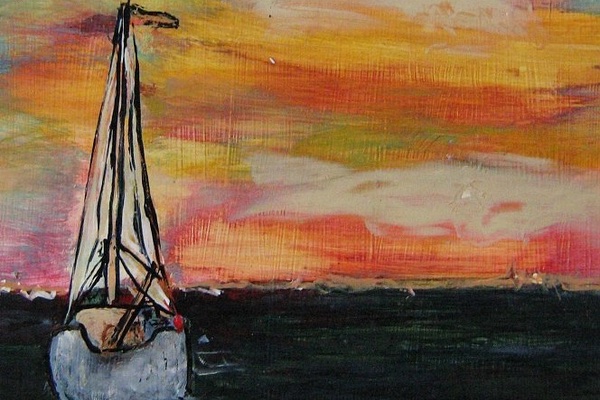By Donald Kolberg
I have been providing lessons on how to create a Strappo and realized that I have modified the technique in a natural progression that I thought I would explain here.
Briefly, Strappo’s are a monotype from a dry acrylic transfer. An acrylic painting is developed and painted in reverse on a clear glass plate. When the image is fully formed and dry, to thicken the acrylic skin, successive layers of acrylic gesso are added. For the transfer process, fresh coats of acrylic gesso are applied both to the back of the glass plate and on the sheet where the image will be placed. The plate is placed on the prepared surface while the fresh gesso surfaces are still wet. Weights are placed to insure contact while the gesso layers bond. After the acrylic layers are bonded, the image and attached surface will be peeled from the glass. It is exactly the image as painted. The image, a monotype, is now transferred and the glass plate is clean. The surface of the image is smooth because it was developed on the smooth surface of the glass. A great advantage is that it does not require the use of a press.

The modifications are created when I add collage and drawing elements to the mix. By first coating the glass surface with a polymer (and letting it dry thoroughly) I am able to create a surface that I can draw on. I use permanent markers to sketch out gestural images and objects and I have also experimented with crayons and lithography pencils. I then coat the surface with polymer and again let it dry.

When I want to add collage elements the layering process starts again. For the Floral pieces I create, I use acrylic paint chips from dried pigment on my palette. This is great for the leaves and blossoms of plants. They are set in place using polymer and then coated with the same medium. Wallpapers in rooms are often designed with pre-painted newspaper or magazine clippings. These collage elements are treated and adhered in the same way as the floral works, alternating layers of polymer with the pieces of ephemera.

The only other adaptation is that after all is said and done instead of adhering the glass to a surface with the use of weights, I peel the dry image from the glass and then apply it to a new surface. This can be paper, cloth and even an existing canvas painting. While these are still Strappo’s, I have also begun to refer to them as Mono-Transfers.
You can see additional examples of Strappo’s and my other artwork at www.donaldkolberg.com. And feel free to email me with any questions.






Oh GREAT post. Definitely will feature. But will hold off for a while since I just fort you up. And don’t be shy about reminding me about it say in a couple of weeks?